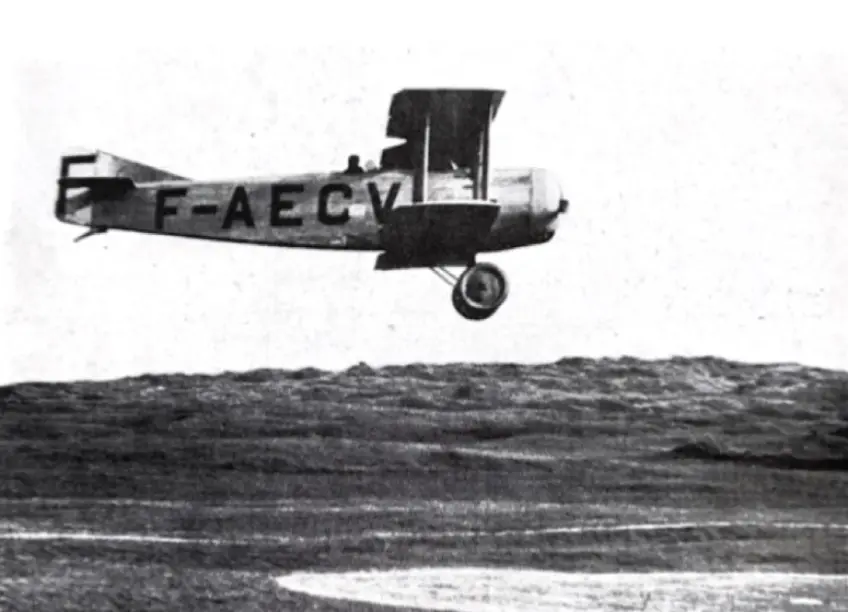In the interwar period, there was a discipline that delighted the crowds: aerial golf. A daring mix of aviation and golf that did not last given the lack of uniform rules and the large means necessary for its practice… We are (almost) sure: Icarus never dreamed of golf, but he certainly thought of birdies and other eagles to fly and thus gain his freedom…
The golfer also wants to reach this Nirvana, perhaps in a way different, but just as illusory: how many times he burned his wings! The comparison does not stop there because it is not only of an ornithological order… Aviation took off at the beginning of the 20th century and when our national hero Louis Blériot was the first to cross the Channel in 1909, thus definitively launching “the sector”, he landed in Dover on… a golf course.
Throughout the years that followed, due to a lack of suitable trails, it was not uncommon for these pioneers to say “hello” on a links. After the First World War, the plane acquired its first letters of nobility and tried to become a means of transport like any other.
The wealthy bourgeoisie fell in love with this modern transport to the point of making it a sporting discipline, reported in the specialized press and even in the golf press. Rallies are organized where sometimes the pilots have to land on the courses and play a few holes…
But the general public rather follows the air meetings which are spreading all over France with various attractions including aerial golf. Its rules differed at the whim of flying clubs as in the good old days of the origins of golf…
Basically, aerial golf consisted of throwing bags of plaster from the top of your machine at marked targets on the ground. Let’s face it, it’s more about aerial petanque, but golf remains very present in the world of aviation thanks to the personalities who frequent it.
Patrons, builders and a few “gentleman-pilots” are often prominent members of golf clubs. Among them, the wealthy American James Gordon Bennett Jr. (1841-1918). This press tycoon, creator of the International Herald Tribune, will give his name to multiple trophies in emerging sports disciplines including the automobile, aviation and of course golf.
Even today, the Gordon-Bennett Trophy (French Open match play) remains a highly coveted competition in the amateur world. Another French entrepreneur tried to popularize aerial golf: a certain André Schelcher (1876-1942), president of Panhard and Levassor automobiles in 1900 and associated with the founding of the Zodiac company in 1908.
Passionate golfer and photographer in his spare time, he was above all considered a brilliant balloonist, airship pilot thanks to whom he took great aerial shots of Paris. An eminent member of the Chantilly golf course, he went there in November 1911 by balloon from St-Cloud to tease the little white ball before leaving in the evening…
Aware of the close relationship between golf and aviation, Schelcher pushes the envelope even further by organizing an event that truly mixes two of his favorite sports. One day in July 1923 at the Touquet golf course, a few flying aces met on the La Forêt course for a test combining skill and precision.
A square green is built there for the occasion. On a perimeter of 50 m on each side, it is delimited by whitewashed bands. In the center of the concentric circles, a 40 cm hole… After taking off from the Berck-sur-Plage aerodrome, “the aero-golfers” try to put the ball in the hole by passing over the ground at a minimum height of 5 meters.
They have 12 balls – identified by the registration letters of their aircraft – to pull off such a feat that would allow them to score 100 points. The rules provide that if the ball falls between 0 and 5 m from the hole, the competitor scores 50 points, 30 points between 5 and 10 m, 20 points between 10 and 15 m, 10 points between 15 and 25 m.
At the end of the day, the referees were able to note the presence of 36 balls out of the 48 in play given the fact that only 4 airmen took part in the tournament… The winner – Jean Bécheler – wins this unique edition with a total of 410 points!
And for good reason: this ace of aviation who had been talked about six months earlier by landing in front of the Grand Palais, was the author of the only hole-in-one of the competition and undoubtedly the first to have made it.
